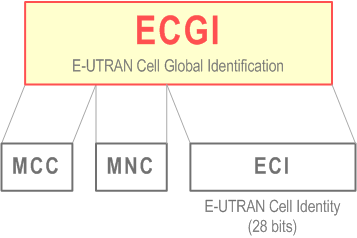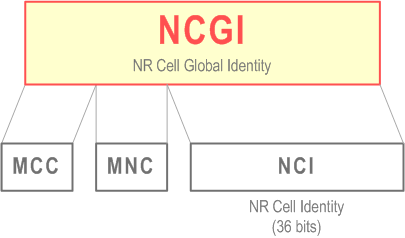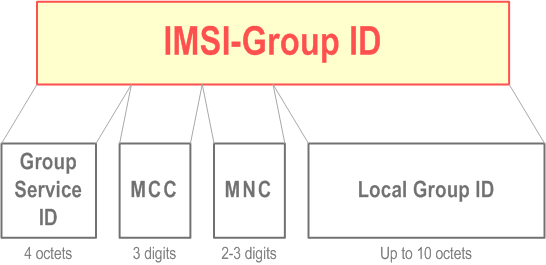Content for TS 23.003 Word version: 19.1.0
1…
2…
2.8…
3…
4…
5…
6…
7…
8…
9…
10…
11
12…
13…
14…
15…
16…
17…
18…
19…
19.4…
19.5…
20…
21…
22…
23…
24…
25…
26…
27…
28…
28.3.2.2…
28.3.2.2.6…
28.3.2.3…
28.4…
28.7…
28.8…
29…
A…
B…
C…
D
E…
19.5 Access Network Identity
19.6 E-UTRAN Cell Identity (ECI) and E-UTRAN Cell Global Identification (ECGI)
19.6A NR Cell Identity (NCI) and NR Cell Global Identity (NCGI)
19.7 Identifiers for communications with packet data networks and applications
19.7.1 Introduction
19.7.2 External Identifier
19.7.3 External Group Identifier
19.8 TWAN Operator Name
19.9 IMSI-Group Identifier
19.10 Presence Reporting Area Identifier (PRA ID)
19.11 Dedicated Core Networks Identifier
...
...
19.5 Access Network Identity p. 92
A trusted non-3GPP access network used by the UE to access EPS can be identified using the Access Network Identity. The Access Network Identity is used as an input parameter in the EPS security procedures as specified in TS 33.402. The format and signalling of the parameter between the network and the UE is specified in TS 24.302 and the format and signalling of this parameter between access network and core network is specified in TS 29.273.
The encoding of the Access Network Identity shall be specified within 3GPP, but the Access Network Identity definition for each non-3GPP access network is under the responsibility of the corresponding standardisation organisation respectively.
19.6 E-UTRAN Cell Identity (ECI) and E-UTRAN Cell Global Identification (ECGI) p. 92
The E-UTRAN Cell Global Identification (ECGI) shall be composed of the concatenation of the PLMN Identifier (PLMN-Id) and the E-UTRAN Cell Identity (ECI) as shown in Figure 19.6-1 and shall be globally unique:

The ECI shall be of fixed length of 28 bits and shall be coded using full hexadecimal representation. The exact coding of the ECI is the responsibility of each PLMN operator.
For more details on ECI and ECGI, see TS 36.413.
19.6A NR Cell Identity (NCI) and NR Cell Global Identity (NCGI) |R15| p. 92
The NR Cell Global Identity (NCGI) shall be composed of the concatenation of the PLMN Identifier (PLMN-Id) and the NR Cell Identity (NCI) as shown in Figure 19.6A-1 and shall be globally unique:

The NCI shall be of fixed length of 36 bits and shall be coded using full hexadecimal representation. The exact coding of the NCI is the responsibility of each PLMN operator.
For more details on NCI and NCGI, see TS 38.413.
19.7 Identifiers for communications with packet data networks and applications |R11| p. 93
19.7.1 Introduction p. 93
This clause describes external identifiers used to facilitate communications with packet data networks and applications (e.g. Machine Type Communication (MTC) applications on the external network/MTC servers) as specified in TS 23.682, TS 23.501 and TS 23.502.
19.7.2 External Identifier p. 93
An External Identifier identifies a subscription associated to an IMSI. A subscription associated to an IMSI may have one or several External Identifier(s).
The External Identifier shall have the form username@realm as specified in Section 2.1 of RFC 4282.
The username part format of the External Identifier shall contain a Local Identifier as specified in TS 23.682. The realm part format of the External Identifier shall contain a Domain Identifier as specified in TS 23.682. As specified in Section 4 of RFC 4282, the Domain Identifier shall be a duly registered Internet domain name. The combination of Local Identifier and Domain Identifier makes the External Identifier globally unique.
The result of the External Identifier form is:
"<Local Identifier>@<Domain Identifier>"
An example of an External Identifier is:
Local Identifier in use: "123456789";
Domain Identifier = "domain.com";
Which gives the External Identifier as:
123456789@domain.com
19.7.3 External Group Identifier |R14| p. 93
An External Group Identifier identifies a group made up of one or more subscriptions associated to a group of IMSIs.
The External Group Identifier shall have the form groupname@realm as specified in Section 2.1 of RFC 4282.
The groupname part format of the External Group Identifier shall contain a Local Identifier as specified in TS 23.682. The realm part format of the External Group Identifier shall contain a Domain Identifier as specified in TS 23.682. As specified in Section 4 of RFC 4282, the Domain Identifier shall be a duly registered Internet domain name. The combination of Local Identifier and Domain Identifier makes the External Group Identifier globally unique.
The result of the External Group Identifier form is:
"<Local Identifier>@<Domain Identifier>"
An example of an External Group Identifier is:
Local Identifier in use: "Group1";
Domain Identifier = "domain.com";
Which gives the External Group Identifier as:
Group1@domain.com
19.8 TWAN Operator Name |R12| p. 94
The TWAN Operator Name identifies the TWAN operator when the TWAN is not operated by a mobile operator.
The TWAN Operator Name shall be encoded as a realm in the form of an Internet domain name, e.g. operator.com, as specified in RFC 1035 and RFC 1123. The TWAN Operator Name consists of several labels. Each label shall consist of the alphabetic characters (A-Z and a-z), digits (0-9) and the hyphen (-) in accordance with RFC 1035. Each label shall begin and end with either an alphabetic character or a digit in accordance with RFC 1123. The case of alphabetic characters is not significant.
19.9 IMSI-Group Identifier |R13| p. 94
IMSI-Group Identifier is a network internal globally unique ID which identifies a set of IMSIs (e.g. MTC devices) from a given network that are grouped together for one specific group related services. It is used e.g. for group specifc NAS level congestion control (see TS 23.401).
An IMSI-Group Identifier shall be composed as shown in Figure 19.9-1.

IMSI-Group Identifier is composed of four parts:
- Group Service Identifier, identifies the service (4 Octets) for which the IMSI-Group Identifier is valid.
- Mobile Country Code (MCC) consisting of three digits. The MCC identifies uniquely the country of domicile of the mobile subscriber;
- Mobile Network Code (MNC) consisting of two or three digits. The MNC identifies the home PLMN of the mobile subscriber. The length of the MNC (two or three digits) depends on the value of the MCC. A mixture of two and three digit MNC codes within a single MCC area is not recommended and is outside the scope of this specification.
- the Local Group Id is assigned by the network operator and may have a length of up to 10 octets.
19.10 Presence Reporting Area Identifier (PRA ID) |R12| p. 95
The Presence Reporting Area Identifier (PRA ID) is used to identify a Presence Reporting Area (PRA).
PRAs can be used for reporting changes of UE presence in a PRA, e.g. for policy control or charging decisions. See TS 23.401, TS 23.060 and TS 23.203.
A PRA is composed of a short list of TAs/RAs, or eNBs and/or cells/SAs in a PLMN. A PRA can be:
- either a "UE-dedicated PRA", defined in the subscriber profile;
- or a "Core Network predefined PRA", pre-configured in MME/S4-SGSN.
19.11 Dedicated Core Networks Identifier |R14| p. 95
A Dedicated Core Network ID (DCN-ID) identifies a Dedicated Core Network (DCN) within a PLMN.
The allowed values of DCN-ID shall be in the range of 0 to 65535.
Values in the range of 0 to 127 are standardized and defined as follows:
0: Spare, for future use
…
127: Spare, for future use
Values in the range of 128 to 65535 are operator-specific.
The use of the standardized DCN-ID is specified in TS 23.401.